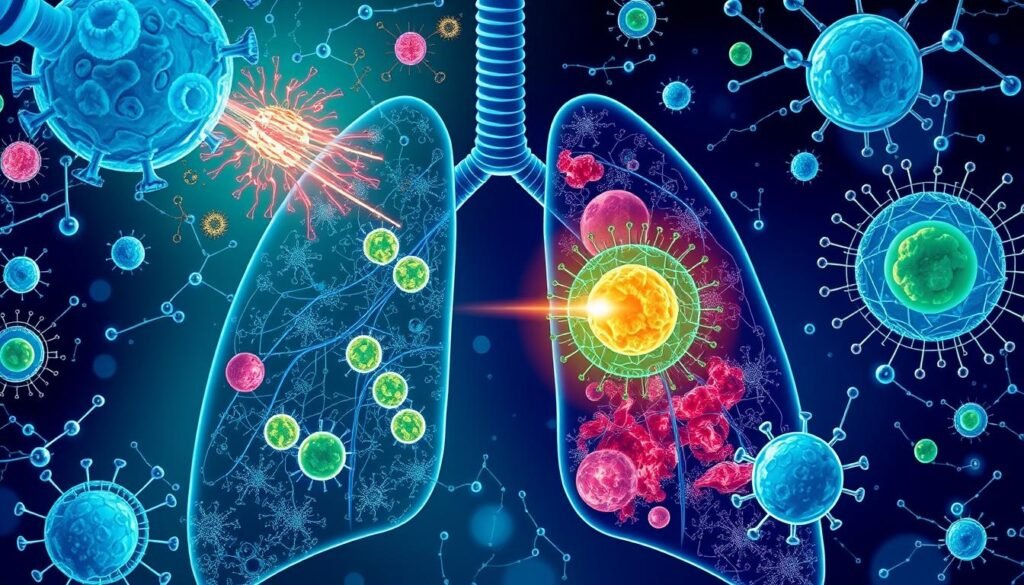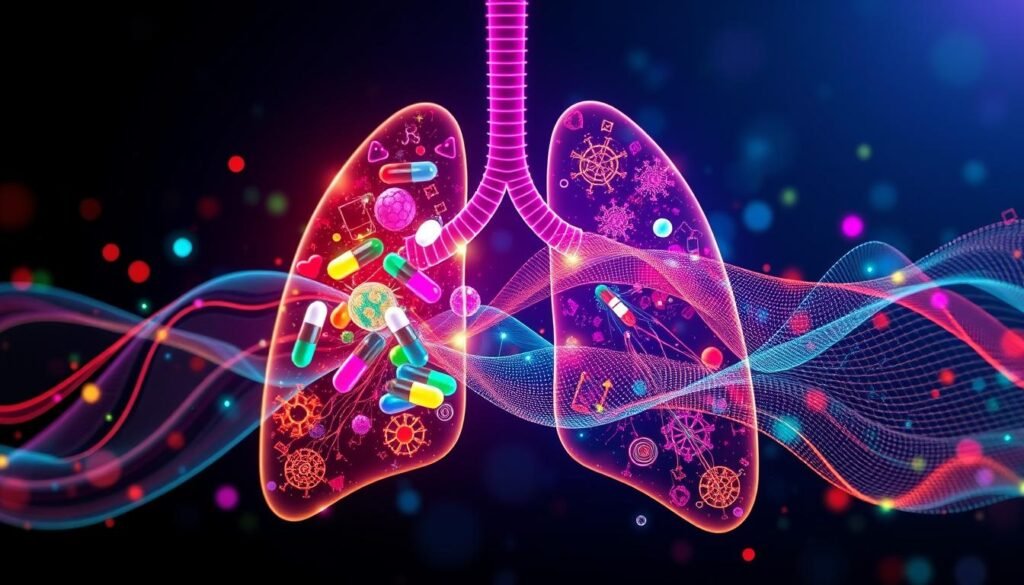Each year, the U.S. sees over 200,000 new cases of non-small-cell lung cancer. This type accounts for over 80% of all lung cancer cases. It underscores the urgent need for effective treatments. Innovations in oncology have led to new options like the lung cancer pill Sotorasib. This pill is a beacon of hope for patients with certain mutations, especially those with the KRAS gene mutation.
In clinical trials, Sotorasib has shown impressive results. It caused tumor shrinkage in 82% of patients. This result is much better compared to traditional treatments. Such advancements mark a big step forward in the fight against lung cancer. They aim to boost survival rates and improve life quality for patients.
Key Takeaways
- Over 200,000 new cases of non-small-cell lung cancer are diagnosed annually in the U.S.
- Non-small-cell lung cancer accounts for more than 80% of all lung cancer cases.
- Sotorasib shows significant efficacy compared to standard therapies.
- Targeted therapies provide tailored treatment options based on genetic mutations.
- Progression-free survival with Sotorasib averages almost seven months.
- Adverse side effects of Sotorasib are manageable and not life-threatening.
Understanding Lung Cancer Types
Lung cancer is a disease that comes in different forms. It’s mainly divided into two groups: non-small cell lung cancer and small cell lung cancer. Here, we talk about non-small cell lung cancer (NSCLC). This type makes up about 80% to 85% of all lung cancer cases. Knowing the types of lung cancer is crucial. It helps doctors choose the best treatment and understand each subtype’s traits.
Overview of Non-Small Cell Lung Cancer
Non-small cell lung cancer is split into three subtypes: adenocarcinoma, squamous cell carcinoma, and large cell carcinoma. These subtypes are different in how common they are, how they’re treated, and the outcomes for patients. This means each one needs a specific approach for the best care.
Different Subtypes and Their Characteristics
- Adenocarcinoma: This is the most common lung cancer type in the U.S. It affects smokers and non-smokers. More women have it than men.
- Squamous Cell Carcinoma: Mostly seen in smokers, this type often starts in the middle of the lungs near the bronchus. It poses unique treatment challenges.
- Large Cell Carcinoma: Known for growing fast and spreading quickly. Its aggressive nature makes treatment difficult.
There are other lung cancer types too but they’re less common. Small cell lung cancer makes up about 10% to 15% of all cases. It spreads quickly, mostly due to smoking. Carcinoid tumors are rare, less than 5% of lung tumors. They grow slowly and are usually less severe.
What is a Lung Cancer Pill?
A lung cancer pill is a type of medicine taken by mouth. It specifically targets lung cancer at its core. These medications focus on certain genetic changes in cancer cells. This makes treatment more effective and suited to each patient’s unique situation. By understanding how these pills work, both patients and caregivers can make better treatment decisions.
Definition and Mechanism of Action
Lung cancer pills, such as crizotinib and alectinib, work by blocking proteins that help cancer cells grow. They are not like traditional chemotherapy. Targeted therapy only goes after cancer cells with specific genetic changes. For example, a small percentage of non-small cell lung cancers have changes in the ALK gene. Crizotinib targets these changes. Patients with certain genetic features often do better with these specific treatments. This can improve their life quality while they are being treated.
Comparison with Traditional Therapies
Chemotherapy attacks all fast-growing cells, whether they are cancerous or not. Targeted therapies, on the other hand, focus only on cancer cells with certain mutations. This key difference means that patients taking lung cancer pills usually have fewer side effects than those on chemotherapy. Traditional chemotherapy drugs, like cisplatin and pemetrexed, can cause major side effects. These include feeling very tired and losing hair. But targeted therapy is more selective, which often results in a gentler experience.
| Type of Treatment | Mechanism | Common Side Effects |
|---|---|---|
| Chemotherapy | Affects all fast-growing cells | Fatigue, hair loss, nausea |
| Targeted Therapy | Targets specific mutations | Milder side effects, fatigue |
Targeted lung cancer treatments offer new hope, especially when the usual options don’t work. More awareness about these treatments gives patients new ways to fight lung cancer.

Targeted Therapy: A New Approach
Targeted therapy is changing how we treat lung cancer. It focuses on the cancer’s specific genetic traits. This allows doctors to create treatment plans tailored to each patient. This leads to better results, especially for those with non-small cell lung cancer (NSCLC).
Unlike traditional chemotherapy, which attacks all rapidly dividing cells, targeted therapy goes after the cancer’s growth mechanisms. This method is key in the fight against lung cancer.
Introduction to Targeted Therapy in Lung Cancer
Targeted therapies are now a big deal in cancer treatment. They work by targeting specific genes that cancer cells need to grow. This means doctors can select the best therapy for each patient, based on their cancer’s genetic makeup. This approach is more effective and has fewer side effects than old-school chemo.
Examples of Targeted Drugs
Today, we have new drugs that offer hope to lung cancer patients. Some drugs stand out:
- Sotorasib (Lumakras™): The first 2021 drug for NSCLC with KRAS mutations. It’s a game-changer for those patients.
- Repotrectinib: It’s great for people with ROS1-positive NSCLC. Patients see strong and lasting benefits.
- Bevacizumab and Ramucirumab: These drugs block tumor blood supply and work well for advanced NSCLC, alone or with other treatments.
Lung cancer is the top cancer killer in the U.S. But, targeted therapy is improving survival rates. By making treatments more specific, we expect even more progress in lung cancer care.

| Drug Name | Target | Approved For | Action Type |
|---|---|---|---|
| Sotorasib (Lumakras™) | KRAS | NSCLC | Small molecule inhibitor |
| Repotrectinib | ROS1 | NSCLC | Tyrosine kinase inhibitor |
| Bevacizumab | VEGF | Advanced NSCLC | Monoclonal antibody |
| Ramucirumab | VEGF | Advanced NSCLC | Monoclonal antibody |
Overview of the New Lung Cancer Pill: Sotorasib
Sotorasib is a big step forward in lung cancer treatment. It specifically helps patients with the KRAS G12C mutation. It’s the first FDA-approved treatment focusing on non-small cell lung cancer (NSCLC) with this mutation. The FDA approval has opened up new possibilities for treatment.
FDA Approval and Indications
The FDA gave the green light to sotorasib for certain lung cancer patients. It’s for those with metastatic or locally advanced NSCLC that have an abnormal KRAS G12C gene. About 13% of NSCLC patients have this mutation. Now, they have new hope thanks to this approval.
Patient Response Rates and Outcomes
Sotorasib has shown good results in clinical trials. The CodeBreaK 100 study showed 51% of patients were alive a year after treatment. After two years, 33% survived. The overall response rate (ORR) was 36%, meaning tumors significantly shrank in these patients.
Responses lasted an average of 10 months. About 25% of patients saw no disease progression for a year. This is compared to only 10% in the docetaxel group.
Side Effects and Clinical Trial Data
Sotorasib looks promising but comes with side effects. Around 70% of trial participants experienced them. These included diarrhea, muscle or bone pain, nausea, and fatigue. Serious side effects occurred in 20% of patients. Because of these, 7% stopped their treatment. Ongoing research is looking into other KRAS mutations for future treatments.
| Clinical Trial Statistic | CodeBreaK 100 | CodeBreaK 200 |
|---|---|---|
| Overall Survival Rate (1 Year) | 51% | 25% (No Disease Progression) |
| Median Duration of Response | 10 Months | N/A |
| Serious Side Effects | 20% | N/A |
| Common Side Effects | Diarrhea, Muscle Pain, Nausea | Diarrhea, Nausea, Fatigue |
New treatments like sotorasib are bringing hope to lung cancer patients with KRAS mutations. For more info on lung cancer treatment breakthroughs, visit this resource.
Cancer Treatment Innovations in Lung Cancer
The search for lung cancer treatments is making great progress. New studies lead to better ways to help patients. These strides focus on targeted solutions that improve lives. Especially in non-small cell lung cancer (NSCLC), modern therapies are key.
Oncology Innovations and Advances
New advances in oncology prove targeted therapies work well. For example, sotorasib helps those with specific lung cancer mutations. It fights tumors directly while keeping side effects low. Other drugs like osimertinib and lorlatinib have been effective for different mutations. Thanks to these developments, treatments can be customized for each person’s needs.
Combination Therapies with Sotorasib
Combining treatments is a new approach showing promise. Using sotorasib with others aims to beat cancer more effectively. Trials are testing it with immunotherapies, like pembrolizumab, to increase survival and decrease risks. These innovative combinations show the potential for better results. They also underscore the value of testing to choose the best treatments. For more on targeted therapy, click here.

| Combination Therapies | Targeted Drug | Indications |
|---|---|---|
| Dabrafenib + Trametinib | Tafinlar + Mekinist | NSCLC with BRAF mutations |
| Nivolumab + Chemotherapy | Opdivo + Platinum-doublet | NSCLC without EGFR/ALK mutations |
| Sotorasib + Pembrolizumab | Targeted + Immunotherapy | KRAS G12C mutation |
Personalized Medicine in Lung Cancer Care
Personalized medicine is leading the way in lung cancer care today. It moves away from the old approach that treated everyone the same. This new method focuses on each patient’s unique genes to decide the best treatment, improving success rates. Genetic tests help doctors find mutations that cause cancer, leading to better, more effective treatment options.
What is Personalized Medicine?
Personalized medicine means customizing healthcare based on the patient’s own characteristics, like their genes. This is changing how doctors treat lung cancer. By using genetic tests, doctors can pick treatments that target the patient’s specific cancer type. This results in fewer side effects and higher success rates compared to standard treatments.
How Genetic Testing Influences Treatment
Genetic testing is key in personalized lung cancer medicine. It lets doctors look at the cancer’s genes to find mutations, like EGFR or KRAS. This information helps choose the right treatment, such as tyrosine kinase inhibitors, which work well against certain mutations. Examples include Gefitinib or Sotorasib, which target specific genetic changes. As genetic testing gets better, personalized medicine will keep improving, making treatments more effective for patients.This article elaborates on the importance of personalized diagnostics, underlining their vital role in creating effective treatment plans.
Broader Treatment Options for Lung Cancer
Lung cancer treatment options have grown a lot, especially for non-small cell lung cancer (NSCLC). Many cancer drugs are now available. They work differently to help patients.
Knowing these options helps patients and caregivers make better decisions. It’s important to understand what choices you have.
Other Drugs for Non-Small Cell Lung Cancer
There are more drugs for NSCLC than just sotorasib. Some include:
- EGFR inhibitors like erlotinib and gefitinib. They target changes in the epidermal growth factor receptor.
- ALK inhibitors such as crizotinib and alectinib. They focus on the anaplastic lymphoma kinase gene.
- Angiogenesis inhibitors like bevacizumab. They cut off the blood supply to tumors.
These cancer drugs work in different ways. They are more effective based on the patient’s unique genetics and the tumor’s traits. For detailed information on lung cancer medications, go to this resource.
Different Mechanisms of Action for Lung Cancer Medications
How lung cancer medications work can change treatment plans:
- Chemotherapy attacks fast-growing cancer cells but might harm healthy ones too.
- Immunotherapy helps the immune system find and destroy cancer cells.
- Targeted therapy aims at specific genetic changes. This can mean better results with fewer bad effects.
Using various approaches in lung cancer treatment is key. It lets doctors customize treatments, aiming for better disease control and patient experiences.
The Impact of Cancer Research on Treatment Options
Cancer research is crucial for the future of lung cancer treatments. It leads to new therapies through studies and clinical trials. This work is key to understanding KRAS mutations and their role in lung cancer.
Recent Findings and Clinical Trials
Recent trials have shown big improvements in treatments. Every year, lung cancer affects about 2.1 million people worldwide. This results in 1.7 million deaths. In the U.S., there were 240,000 new cases in 2023, with 130,000 deaths. Since non-small cell lung cancer makes up 85-90% of these cases, research is vital.
Immunotherapy is a new, effective treatment. It has FDA approval and can cause long-lasting remission and better survival rates. For instance, the Cancer Research Institute funded breakthroughs in anti-PD-1 checkpoint immunotherapy.
Top cancer centers in the U.S. work together to improve treatments. Their research on tumor DNA and new therapies looks promising. They aim to make lung cancer treatments more precise by studying different proteins and pathways.
| Statistic | Data |
|---|---|
| Global Lung Cancer Cases Annually | 2.1 million |
| Global Lung Cancer Deaths Annually | 1.7 million |
| New Lung Cancer Cases in the US (2023) | 240,000 |
| Lung Cancer Deaths in the US (2023) | 130,000 |
| NSCLC Cases Percentage | 85-90% |
| Major Types of Lung Cancer |
|
| Recent Immunotherapy Approvals | Multiple |
Conclusion
The world of lung cancer treatment is changing fast, thanks to new options like Sotorasib. This pill could change how we fight non-small cell lung cancer. With more research, we’ll have even more ways to help patients live longer and better lives.
Nowadays, medicine is getting more personal, especially in cancer treatment. Targeted therapies bring new hope. Knowing more about a patient’s genes helps doctors find the best treatment. This move towards personalized medicine is a game-changer in the fight against lung cancer.
Lung cancer patients face extra risks, like COVID-19. But, the progress in targeted treatments is a big step up. Ongoing trials and research show we’re committed to improving lives. This continues to give patients hope on their path to recovery.